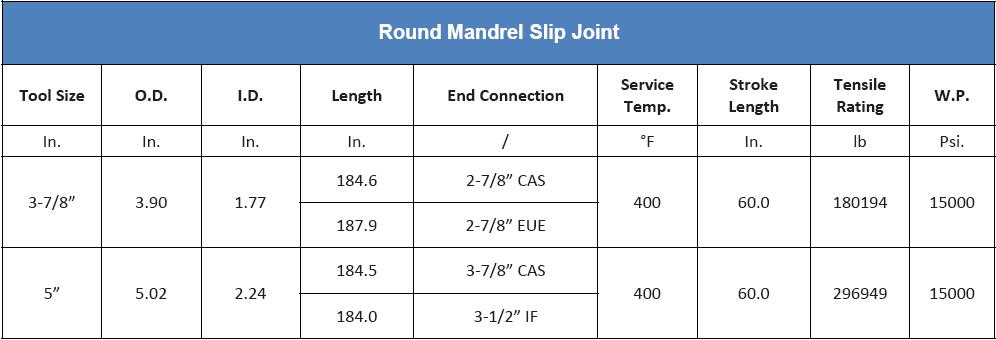Popular Name: Round Mandrel Slip Joint
The Round Mandrel Slip Joint, like other slip joints, accepts the movement associated with ocean heave or temperature change without allowing the movement to disturb the placement of downhole tools.
The round mandrel slip joint has the following characteristics:
• Maintains its full tensile rating when collapsed and locked
• Can be locked in the closed position for handling, reducing the risk of damage to the lifting/sealing mandrel
• Internally pressure and volume balanced
• String can be picked up with the slip joint locked; the slip joint can then be unlocked before it is run into the hole
• Provides free travel in the string to reciprocate tools without unseating the packer
A slip joint operates by balancing its volume. As the slip joint stretches and increases its internal volume, a differential piston within the slip joint allows the same volume of fluid into the pipe. The net result is no change in internal volume. Each slip joint has 5 ft (1.52 m) of travel but can be combined with other slip joints to provide additional travel. When multiple slip joints are run, they are normally connected to one another rather than located throughout the pipe string. The number of slip joints required depends on ocean heave and the amount of expected contraction and expansion.
Features
1) Provides a variable-length joint to allow the pipe to expand and contract during testing or stimulation
2) Keeps vertical movement of the drilling vessel from disturbing tool placement
3) Helps space out the testing string when the subsea tree is landed
4) Provides a constant weight on the packer during testing or stimulation
Operation
The weight of the toolstring (excluding tools, anchor, and traveling blocks) is used to determine the location of the slip joint. Once the necessary packer-setting weight is shown on the weight indicator, the slip joint is placed into the string. When multiple slip joints are used, the top joint makes its complete travel, then the next joint down makes its travel, and so on. The weight indicator may show a slight bump as each slip joint reaches the end of its travel.


1) Other sizes available on request.
2) Meets requirements of NACE-0175 (>175°F)
3) The values of tensile, burst, and collapse strength are calculated with new tool conditions.
4) Pressure rating is the differential pressure at the tool. (Differential pressure is the difference in pressure between the casing annulus and the tool ID.)
